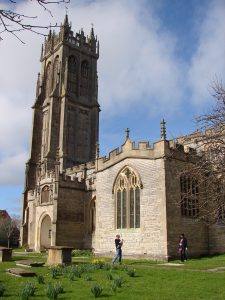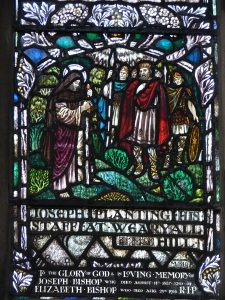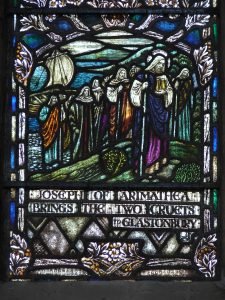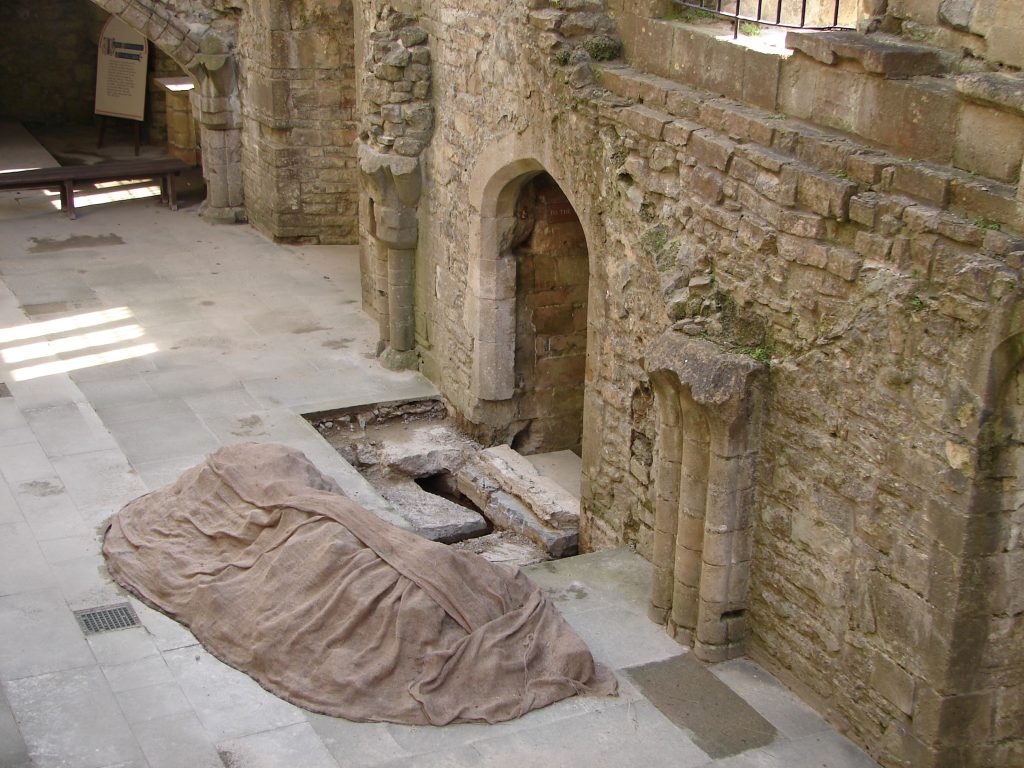 My next few postings will feature medieval topics from, Joseph of Arimathea’s Treasure, the fifth book in my Lady Apollonia West Country Mysteries. The story is set in Glastonbury, Somerset. Since the title features the New Testament character Joseph of Arimathea, I would like to use this posting to explore some of the legends about the real Joseph of Arimathea coming to Glastonbury.
My next few postings will feature medieval topics from, Joseph of Arimathea’s Treasure, the fifth book in my Lady Apollonia West Country Mysteries. The story is set in Glastonbury, Somerset. Since the title features the New Testament character Joseph of Arimathea, I would like to use this posting to explore some of the legends about the real Joseph of Arimathea coming to Glastonbury.
Some of these legends are contained in the stained-glass windows of Saint John the Baptist, one the parish churches in Glastonbury. Others represent Joseph of Arimathea as presented in the New Testament. This parish church on the High Street of Glastonbury is shown on the left. Pictures of two of its stained-glass windows are included in this posting.
Many of the legends of Joseph of Arimathea and the West Country of England cannot be traced back earlier that the 13th century. Some of these were promoted by the abbots in Glastonbury, particularly in the 14th century when my story is set. These include the story that Joseph brought the teenage Jesus to Glastonbury and other places in the West Country and that he later came back after the Crucifixion and planted his staff on Wearyall Hill in Glastonbury. The staff then grew into the original Glastonbury Thorn, a variety still found in the Holy Land. Several cuttings of this thorn are located around Glastonbury, and some of its bloom is sent every Christmas as a present to Queen Elizabeth II. The window showing the event of Joseph planting his staff is above on the right.
 The legends go on and on concerning Glastonbury. Some say that Joseph brought to Glastonbury two vials containing the blood and sweat of Jesus, as depicted in the stained-glass window shown on the left. A variation on this is that Joseph brought the Holy Grail to England and hid it in a well at Glastonbury, now called the Chalice Well. The water of this well is red, suggesting the blood of Christ. There are also stories of Joseph being buried in Glastonbury with the Holy Grail.
The legends go on and on concerning Glastonbury. Some say that Joseph brought to Glastonbury two vials containing the blood and sweat of Jesus, as depicted in the stained-glass window shown on the left. A variation on this is that Joseph brought the Holy Grail to England and hid it in a well at Glastonbury, now called the Chalice Well. The water of this well is red, suggesting the blood of Christ. There are also stories of Joseph being buried in Glastonbury with the Holy Grail.
Other legends about Joseph of Arimathea have suggested that Joseph was the uncle of the Virgin Mary, mother of Jesus. This might explain his interest in the teenage Jesus as well as the crucified Jesus. Others have proposed that Joseph was a merchant whose interest in England may have originated with the desire to purchase tin from Cornwell. We do know that the Greeks had a trade route established for Cornish tin by the 8th century BC. At the time of Joseph. there was a Jewish presence in the West Country of England, including in the mining of tin.
Some feel that Joseph was the first person to bring Christianity to Britain and establish the first church. These legends often focus on Glastonbury, with the first church being on the site where the Lady Chapel of the medieval abbey church was located. There is a well in the crypt of that chapel which was named for Joseph of Arimathea, and it plays a role in my story. Other variations of the legends have Joseph founding a monastery with Saint Patrick being one of its early abbots. A picture of the entry to this well is shown in the photo at the end of this posting.
None of these legends can be proved to be true. Many that appeared in the Middle Ages were probably created because it helped someone’s agenda by increasing pilgrimage to a religious site such as Glastonbury Abbey. Apart from these legends, all the Gospels in the New Testament of the Christian Bible tell us something about Joseph of Arimathea at the time of the death of Jesus. From the Gospels we know he was a wealthy member of the Sanhedrin who originally came from Arimathea in Judea and participated in the burial of Jesus by offering his tomb. From this biblical narrative, the legends described above grew and developed over many centuries.
In the next posting I will tell more about the history of Glastonbury.
